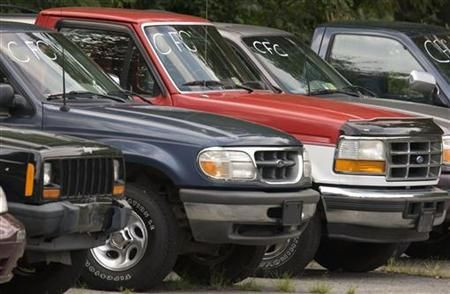Critics Say Obama's 'Cash For Clunkers' Program Hurt The Economy, Environment, But Not Everyone Is Buying It

President Obama was praised in 2009 when his administration enacted the “Cash for Clunkers” program, which was designed to encourage the public to turn in older cars in exchange for rebates toward the purchase of new, fuel-efficient cars. The goal of the program was to increase the number of fuel efficient vehicles on the road and stimulate the car industry and larger economy. But new information, which has surfaced just weeks before Obama will be inaugurated as president for the second time, reveals that while the program may have been a good one, its execution was flawed.
Nearly a million Americans participated in the Cash for Clunkers program, officially known as the Car Allowance Rebates System (CARS), as they traded in their gas-guzzlers for as much as a $4,500 rebate toward the purchase of a new vehicle. In many situations, that sum was more than the actual value of the old car.
Aside from a few parts, cars driving on the roads today are almost completely recyclable, so proponents of the Clunkers program naturally assumed that older automobiles would be salvaged in some way and the remaining parts would be auctioned off for a small price.
Instead, many of the 690,000 engines in the vehicles that were traded in were shredded, producing about 500 pounds of “shredding residue” that emits polyurethane foams, metal oxides, glass and dirt into the air, according to TakePart.com. Other shredded cars, a number of which had fuel efficiency levels near the recommended level, were deposited into landfills.
Some car dealers also had complaints about Obama’s program, although it was likely their motivation for participating in the program was profit and not what was best for the environment -- or for consumers who were sick of spending so much at the pump.
“The program destroyed approximately 750,000 working vehicles,” dealer Mike Smith wrote in an opinion piece for TriCities.com. “They were crushed and sold for scrap metal, primarily to China. This created a severe shortage of affordable, reliable cars for folks like my customers who cannot afford newer, expensive cars. For independent dealers like me, the availability of used cars to resell diminished drastically, while prices skyrocketed.”
Other pundits, who presumably had less emotion invested in the matter, deemed the program successful, at least in the sales column. At $3 billion, it stimulated three times the growth that was originally expected.
“The program accomplished what it set out to do, which was to get consumers back into showrooms and to jump-start new vehicle sales,” Joseph R. Szczeny wrote in Time's Business & Money section in 2009. However, he admitted the program “was overly complicated.”
“More importantly, the program was a lifeline thrown at severely cash-strapped dealers. Sales were up. So were the profits. Consumers tend to drop their guard when there are big incentives, assuming that they will get great deals no matter what. As the clunker sales reached a fevered pitch, I think it's fair to say that the deals got much stingier. Many shoppers could have gotten better deals if they had done their homework before going to the dealership.”
© Copyright IBTimes 2024. All rights reserved.





















